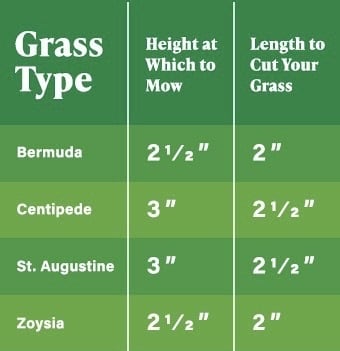The Ideal Mowing Height for Warm Season Grasses
As the seasons change, your lawn maintenance routine should too. Warm-season grasses will soon enter their growing season, but you can prepare for the spring and summer months now. Grow the lawn of your dreams with our best mowing practices for warm-season turfgrass.
What is Warm Season Grass?
Warm-season grasses thrive during the summer months when temperatures are above 75°F. The primary types of turfgrass in this category include:
Why is Mowing Your Grass Important?
Mowing is one of the most popular agricultural practices, due to the essential role it plays in nutrient absorption and growth. Frequent mowing is necessary for your lawn to grow evenly and maintain its aesthetic appeal.
Ideal Heights for Warm Season Grasses
The ideal height for warm-season grasses is 2-2.5.” In the spring, you’ll want to cut your grass on the shorter side to remove any lingering winter damage. While warm-season grasses have their similarities, each species does well at a specific height.

Things to Avoid When Mowing Your Warm Season Grasses
While mowing your lawn may seem pretty straightforward, we’ve outlined a few common mistakes people often make.
Cutting Too Much at One Time
Infrequent mowing increases the chance that you remove too much of the grass blade. Removing more than ⅓ of an inch may stress the grass, increasing the chances of problems further down the road. If your grass is too long, gradually cutting it over a span of several days is the best course of action.
Not Sharpening Your Mower Blades
Just like a dull knife, blunt mower blades don’t make a clean cut. Instead, the blades will shred the grass, making it more susceptible to damage from heat, disease and pests. Since the grass is unable to recover, it may eventually begin to brown or thin out.
Not only is a dull blade bad for your grass, but your equipment will suffer too. Mowing consistently with dull blades overtaxes your machine, reducing its lifespan and bringing costly repairs—or replacements. Your mower blades should be sharpened after 20-25 hours of use to prevent damage to your lawn.
Removing the Grass Clippings
Depending on their length, removing grass clippings may deprive your lawn of essential nutrients. Short clippings—measuring one inch or less—will decompose quickly and return vital nutrients back into the soil. Longer clippings should be removed because of their tendency to block sunlight.
Prepare for the Warm Season with Barefoot Lawn Care
Ramping up for the warmer months? Let us take care of you! Barefoot Lawn Care provides lawn maintenance, preventative turf care and seasonal services for all NC turfgrass types. Contact us to request your free lawn analysis today!